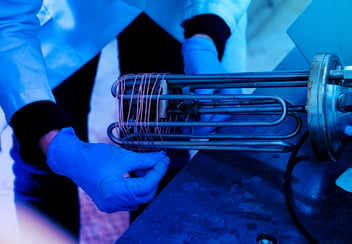Dober Coolant Corrosion Inhibition in Aluminum Alloys
Electrical vehicles have cooling systems using different metals than those of ICE vehicles.
Research has shown different aluminum alloys are used in electrical vehicles in the U.S., Europe and Asia. All of these aluminum alloys need corrosion inhibition protection.
That is why specific corrosion inhibitors are added to battery-electric vehicle (BEV) and fuel-cell (FC) coolants.
At Dober, FC and BEV coolants are developed and tested for corrosion protection of various types of aluminum alloys. Specifications for testing BEV and FC coolants are in progress and have not yet been finalized by ASTM and other global organizations, like the International Organization for Standardization (ISO). (Update: Since the publication of this article, ASTM published new test standards for electric vehicle coolants.)
In the absence of standardized test methods, Dober has developed in-house test methods and has followed ASTM D1384 test methodology.
Dober scientists realized that BEVs operate at lower temperatures and corrosion water is not required for testing these BEV coolants. Coolants for fuel-cell vehicles have different requirements, namely temperature of 80 degrees Celsius, plus longer duration of testing.
OEMs use a variety of aluminum metal alloys. As such, dedicated coolant formulations are needed for EV and FC OEMs.
The following table provides a list of aluminum alloys used by Asian and European OEMs.
|
Aluminum Alloy |
Country |
|
Cast Aluminum 319 |
Global |
|
5052 Aluminum |
Global |
|
6061 Aluminum |
Global |
|
AC4C Aluminum |
Korea |
|
ALDC12 Aluminum |
Korea |
|
7075 Aluminum |
Korea |
|
AL3A21 Aluminum |
China |
|
AL5A05 Aluminum |
China |
|
AL6003 Aluminum |
China |
In this article we will use ASTM D1384 test results to compare different coolants by corrosion effect on various aluminum alloys.
Corrosion inhibition: Dober vs. the competition
Dober performed D1384 tests for cast aluminum 319 using Dober FC Coolant ULC, European and NP competitor coolants. Results are shown below (a negative number indicates weight gain, while a positive number indicates weight loss).
|
Coolant |
Dober FC Coolant ULC |
European Competitor |
NP-Competitor |
ASTM D1384 Limits MAX, mg |
|
Copper |
-1.58 |
0.77 |
37.17 |
10 |
|
Solder |
8.15 |
26.60 |
170.15 |
30 |
|
Brass |
-0.23 |
2.47 |
98.62 |
10 |
|
Steel |
144.83 |
807.53 |
7437.38 |
10 |
|
Cast Iron |
163.77 |
1050.77 |
5110.12 |
10 |
|
Cast Aluminum 319 |
-4.27 |
1.73 |
109.13 |
30 |
Dober’s results are better than both the European competitor and the NP competitor.
We also performed corrosion tests for AC4C Aluminum, ALDC12 Aluminum and 7075 Aluminum alloys. The results, shown below, were compared with European and Asian competitors.
|
Coolant |
Dober FC Coolant ULC |
European Competitor |
Asian Competitor |
|
AC4C Aluminum |
-3.47 |
-2.87 |
-4.07 |
|
ALDC12 Aluminum |
-3.67 |
-3.07 |
-3.57 |
|
7075 Aluminum |
-3.37 |
-2.87 |
-3.37 |
|
304L Steel |
-1.37 |
-0.77 |
-1.17 |
|
316L Steel |
-1.07 |
-1.07 |
-0.67 |
Dober scientists do not test and observe weight loss or gain but minutely observe test coupons which indicates which coolant is better despite having passed the ASTM D1384 test limits. Visually, Dober’s coolant was much better on aluminum alloys than competitors (as shown below).

In short, Dober coolants can protect many types of aluminum alloys from corrosion under specified test conditions by OEMs.
Want to learn more about Dober's corrosion inhibition additives and our EV and FC coolants? Reach out to us and we'd be happy to chat.


-1.png?width=352&name=PFD%20-%20Product%20Page%20-EV%20SLC%20(2)-1.png)

.png?width=352&name=PFD%20-%20Product%20Page%20-EV%20SLC%20(2).png)